Before packing, check this list of items prohibited from entering a particular country or region.
Key takeaways
- The most expensive city in the world is Singapore, tied with Zurich, according to the Economist Intelligence Unit's (EIU) latest Worldwide Cost of Living survey.
- The most expensive cities in the US are New York City (New York), Los Angeles (California), San Francisco (California), Honolulu (Hawaii) and Washington, D.C. (District of Columbia).
- The most expensive cities in Europe are Zurich (Switzerland), Geneva (Switzerland), Paris (France), Copenhagen (Denmark) and Oslo (Norway).
What is the most expensive city in the world?
The most expensive city in the world is Singapore, tied with Zurich, according to the Economist Intelligence Unit's (EIU) latest Worldwide Cost of Living survey, followed by Geneva, New York, Hong Kong, Los Angeles, Paris, Copenhagen, Tel Aviv and San Francisco.
The EIU's biannual survey has been analysing the cost of living in 173 cities worldwide for over thirty years. Its global researchers compile the list by comparing a basket of like-for-like consumer goods and services, including groceries, entertainment expenses, clothing, utility costs, public transport, and accommodation. From this data, the EUI factors in current currency fluctuations, inflation rates, and shifting market dynamics to deliver a comprehensive analysis, providing invaluable data for businesses, policymakers, and curious minds alike.
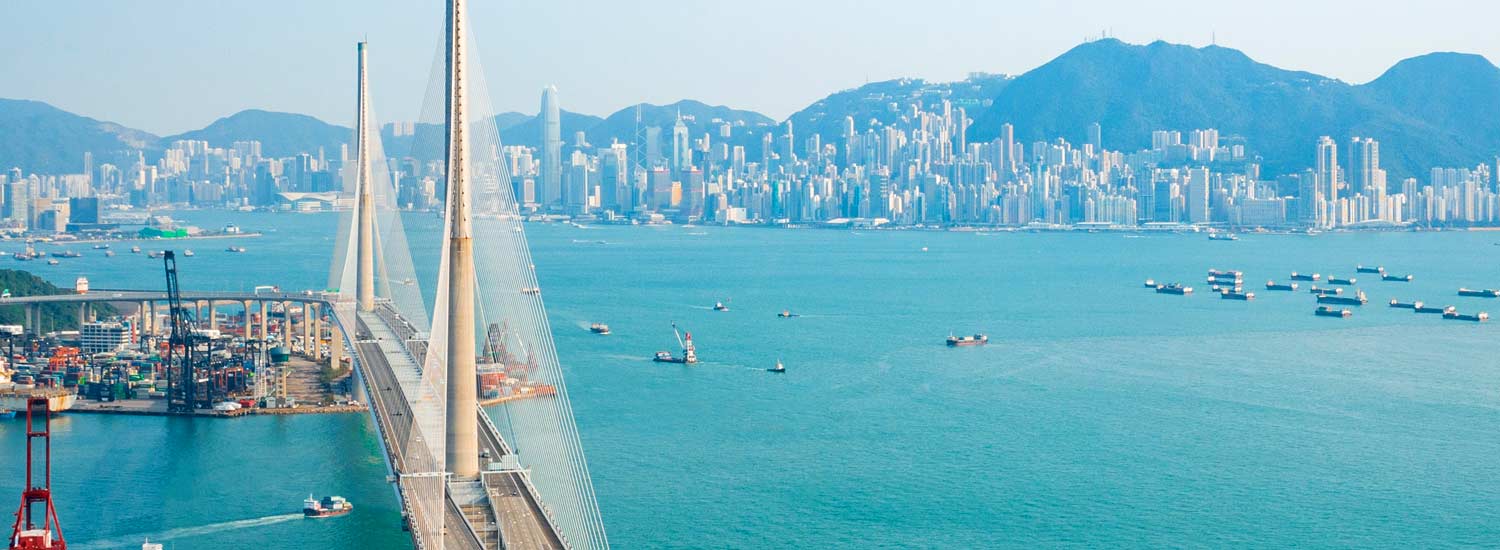
6 highest cost of living cities
It's the ninth time Singapore has sat in pole position in eleven years.
1. Singapore
Singapore's status as one of the world's most expensive cities is a testament to its unique blend of economic dynamism and urban sophistication. Boasting a strategic location at the crossroads of global trade routes, Singapore has emerged as a thriving hub of commerce and finance in the heart of Southeast Asia.
Thanks to excellent healthcare, infrastructure, and education, the city-state offers plenty of chances for career advancement and a high quality of life. However, its small size has led to an unstoppable demand for real estate causing property prices and rental rates to soar.
2. Zurich (Switzerland)
Nestled amidst breathtaking Swiss scenery, it's no surprise that Zurich's picturesque surroundings, impeccable cleanliness, and high living standards come with a hefty price tag.
Another global financial powerhouse and a leading centre for banking, the city's robust economy, fueled by a strong currency and stable political environment, attracts a steady stream of affluent individuals, driving demand for premium properties and luxury goods.
3. Geneva (Switzerland)
Geneva, Switzerland's second-most populous city, is a cosmopolitan hub on the shores of Lake Geneva. Known for its diplomatic significance as the European headquarters of the United Nations, the city is a bastion of high-class living and a magnet for those with a high net worth.
Plus, Switzerland's reputation as a tax haven has long been a lure for the wealthy seeking financial security and favourable fiscal policies. However, this influx exacerbates competition for housing and services.
4. New York City (USA)
From Broadway to Wall Street, New York is a vibrant melting pot of culture and commerce. The city that never sleeps draws high-income earners from across the globe due to world-class restaurants, upscale properties and iconic nightlife.
However, the cost of real estate in Manhattan is notoriously high. And skyrocketing rents and housing prices, particularly in desirable neighbourhoods like Chelsea, SoHo, and Greenwich Village, have made homeownership a distant dream for many New Yorkers.
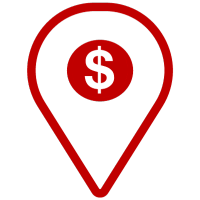
Most expensive cities to live in
The most expensive cities to live in are Singapore, Zurich, Geneva, New York, Hong Kong, Los Angeles, Paris, Copenhagen, Tel Aviv and San Francisco, according to the EIU's most recent Worldwide Cost of Living survey.
It's the ninth time Singapore has sat in pole position in eleven years. However, Europe is the continent with the priciest cities, with four of them in the top ten, against the US's three, with North American cities, on average, slipping down the cost-of-living ranking.
Distribution of expenses in the top 3 costliest cities:
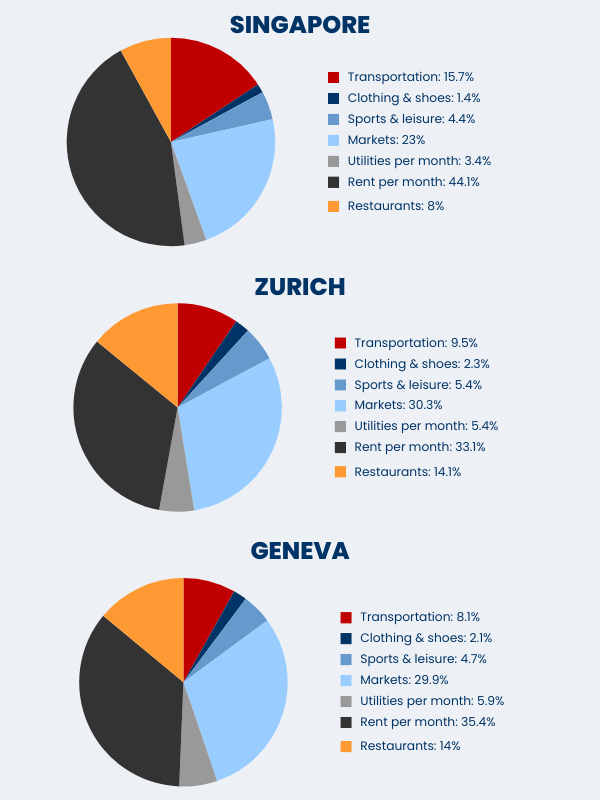
Source: www.numbeo.com
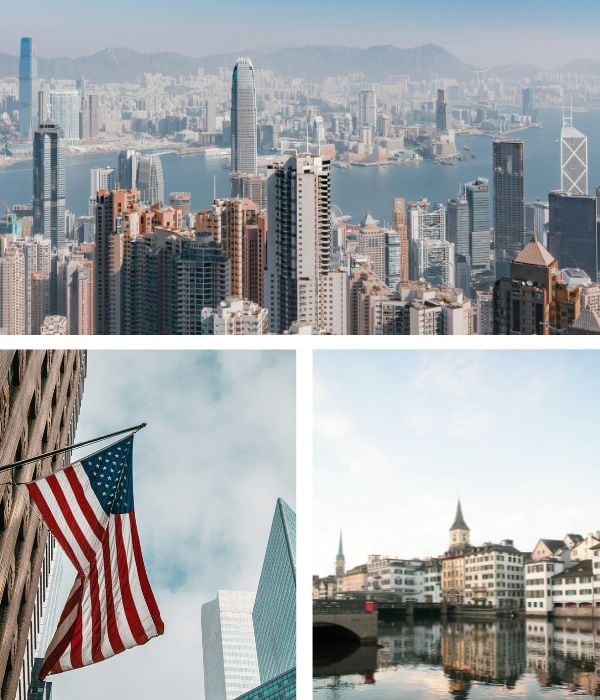
5. Hong Kong
The dazzling jewel of the East, Hong Kong's reputation as one of the world's most expensive cities stems from its strategic location as a gateway to China and its status as a financial powerhouse. However, with limited land available and businesses, professionals, and investors all vying for a piece of the action, demand for real estate in Hong Kong is relentless.
Although tiny apartments and sky-high rents are the norm, the city's robust economy, world-class infrastructure, and sparkling streets make the expense of daily life worth it.
6. Los Angeles (USA)
Los Angeles, the epitome of the American Dream with its palm-lined streets and iconic Hollywood sign, is renowned for its glamorous allure. One of the main factors driving up the cost of living in this sun-soaked metropolis is its booming real estate market. From trendy neighbourhoods like Beverly Hills and Santa Monica to hip enclaves such as Silver Lake and Venice Beach, renting is the only affordable option for those yet to strike it lucky.
The city's sprawling layout and heavy traffic also contribute to high transportation costs, as residents spend significant time and money commuting between home, work, and leisure destinations.
What is the most expensive state to live in?
The most expensive state to live in is Hawaii, where cost of living is
84% higher than US avg.
Source: Payscale
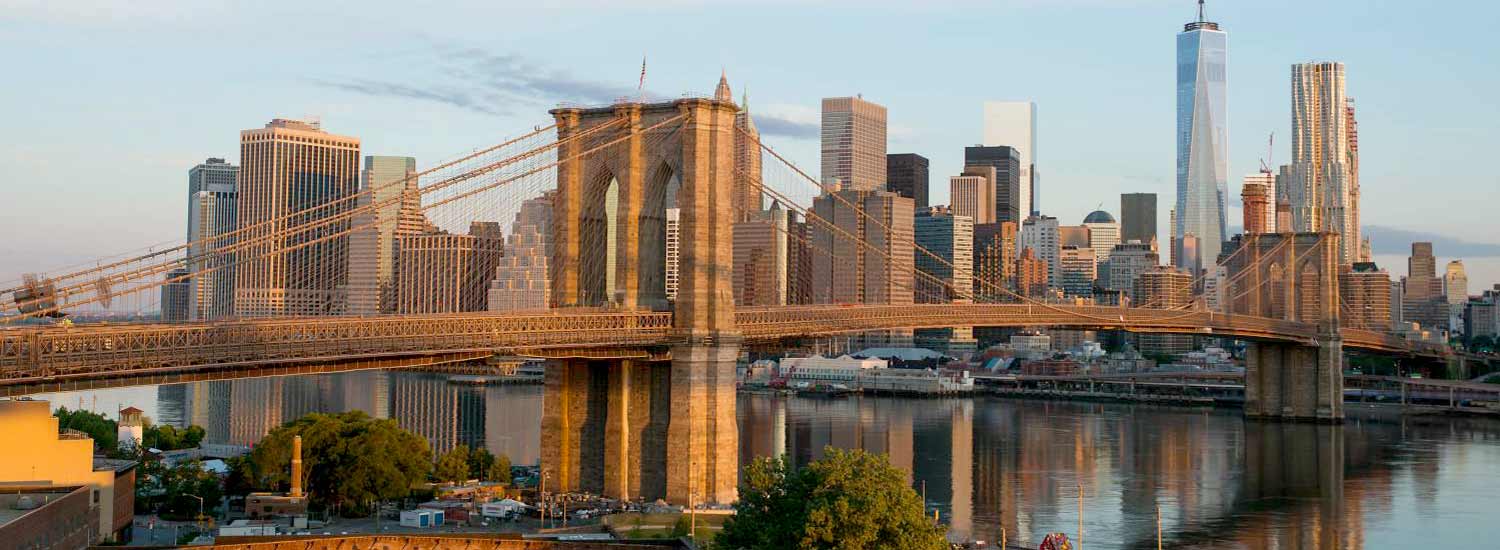
Most expensive cities in the US*
The most expensive cities in the US are New York City (New York), Los Angeles (California), San Francisco (California), Honolulu (Hawaii) and Washington, D.C. (District of Columbia).

New York City, New York
From Broadway shows and world-class museums to iconic landmarks like Central Park and the Statue of Liberty, New York City offers endless opportunities for entertainment and recreation.
However, space is at a premium, and taxes are steep, making it a challenge for residents to find affordable housing while covering the costs of everyday essentials.
Cost of living: 128% higher than the US average
Median house price: $2,184,673 (€2,033,712)
Median rent: $6,642 (€6,183) per month
Avg. energy bill: $183 (€170) per month
Avg. petrol cost: $3.93 (€3.66) per gallon
Avg. annual salary: $82,000 (€76,334)
Most expensive neighbourhoods: Hudson Yards, SoHo, TriBeCa, Carroll Gardens and Flatiron District

Facts about the cost of living in the US
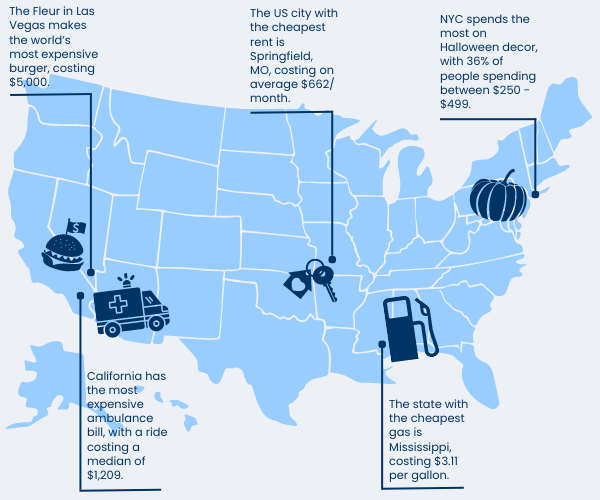
![]()
Los Angeles, California
The City of Angels boasts a vibrant lifestyle but at a hefty cost. Exorbitant fuel and property prices are the principal factors for LA's reputation as the US's second most expensive city.
However, despite the challenges, many budding actors, musicians, and entrepreneurs are drawn to Los Angeles's sunny weather, diverse culture, and booming entertainment and tech industries.
Cost of living: 51% higher than the US average
Median house price: $1,083,995 (€1,009,091)
Median rent: $3,296 (€3,068) per month
Avg. energy bill: $196 (€182) per month
Avg. petrol cost: $4.36 (€4.06) per gallon
Avg. annual salary: $87,000 (€80,988)
Most expensive neighbourhoods: Bel Air, Beverly Crest, Venice, Hollywood Hills West and Cheviot Hills

San Francisco, California
San Francisco's status as a tech mecca comes with a formidable cost of living. Even modest condos sell for huge prices, squeezing budgets and prompting creative housing solutions like co-living arrangements and micro-apartments.
Yet, amidst these challenges, Frisco's progressive ethos and innovative spirit continues to captivate, making it a city of both opportunity and resilience.
Cost of living: 79% higher than the US average
Median house price: $1,386,107 (€1,290,327)
Median rent: $4,214 (€3,923) per month
Avg. energy bill: $234 (€218) per month
Avg. petrol cost: $4.70 (€4.38) per gallon
Avg. annual salary: $113,000 (€105,192)
Most expensive neighbourhoods: Presidio Heights, Sea Cliff, Presidio Terrace, Cow Hollow and Marina District
![]()
Honolulu, Hawaii
Honolulu's breathtaking beauty, warm climate, and Aloha spirit make it a coveted destination. However, due to Hawaii's isolated location, the island relies heavily on imports, making groceries and everyday essentials pricey.
And with everyone looking for their own little slice of paradise, the property market is expensive, with median home prices well above the national average.
Cost of living: 84% higher than the US average
Median house price: $1,417,220 (€1,319,290)
Median rent: $4,309 (€4,011) per month
Avg. energy bill: $251 (€234) per month
Avg. petrol cost: $4.27 (€3.97) per gallon
Avg. annual salary: $77,000 (€71,679)
Most expensive neighbourhoods: Kahala, Diamond Head, Waikiki, Black Point and Portlock
![]()
Washington, D.C.
The United States capital is the country's political heart. The continuous influx of tourists and affluent residents, attracted by the city's history and exciting employment opportunities, leads to tough competition for accommodation and steep costs.
Additionally, residents of D.C. face some of the highest tax rates in the country, including income, property and sales taxes.
Cost of living: 39% higher than the US average
Median house price: $1,117,362 (€1,040,152)
Median rent: $3,397 (€3,162) per month
Avg. energy bill: $171 (€159) per month
Avg. petrol cost: $3.56 (€3.31) per gallon
Avg. annual salary: $86,000 (€80,057)
Most expensive neighbourhoods: Georgetown, Kalorama, Capitol Hill, Spring Valley and Chevy Chase
Source: Payscale
*according to costs and exchange rates on the day of writing.
What does cost of living refer to?
Cost of living refers to the amount of money required to sustain a certain standard of living in a particular location over a specified period. It encompasses various expenses such as housing, groceries, transportation, healthcare, utilities, and entertainment.
Other factors influencing the cost of living include housing prices, taxation, inflation rates, availability of goods and services, and overall economic conditions. Living cost indexes compare the affordability of different cities or regions, with the higher positions on the index indicating higher costs. Understanding the cost of living is essential for budgeting a move abroad and assessing the affordability of living in a specific area.

Most expensive cities in Europe*
The most expensive cities in Europe are Zurich (Switzerland), Geneva (Switzerland), Paris (France), Copenhagen (Denmark) and Oslo (Norway).
![]()
Zurich, Switzerland
As Switzerland's economic powerhouse and one of Europe's most desirable cities, Zurich's cost of living is notoriously high, driven by steep housing costs.
Although a move to Switzerland requires careful budgeting and financial planning, Zurich offers residents access to top-notch healthcare and education against a stunning Alpine backdrop.
Single person est. monthly costs: 4,454 CHF ($4,902)
Avg. property price per m²: 10,392 CHF ($11,437)
Avg. monthly rent: 2,853 CHF ($3,140)
Avg. monthly utility bill: 284 CHF ($313)
Avg. petrol cost: 1.84 CHF ($2.03) per litre
Avg. annual salary: 100,000 CHF ($110,057)
Most expensive neighbourhoods: Seefeld, Fluntern, Hottingen, Enge and Escher Wyss

Facts about the cost of living in Europe
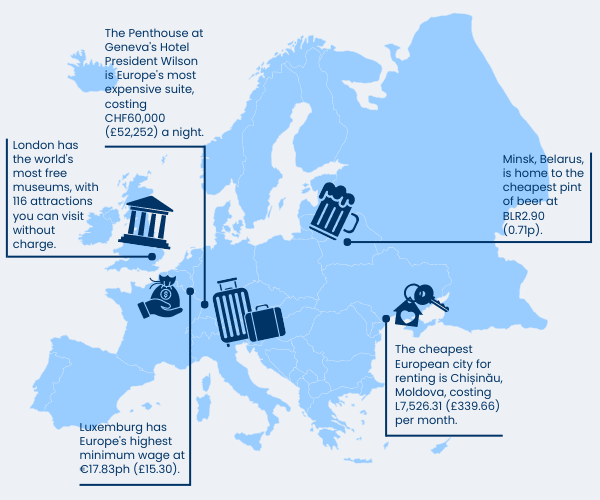
![]()
Geneva, Switzerland
Geneva, Switzerland's cosmopolitan gem, is renowned for luxury and refinement. However, finding affordable housing can be challenging because the city only covers a small geographic area.
Fortunately, from the World Health Organisation to the United Nations, Geneva is a magnet for diplomacy, finance, and international organisations, providing ample job prospects.
Single person est. monthly costs: 4,541 CHF ($4,998)
Avg. property price per m²: 15,826 CHF ($17,418)
Avg. monthly rent: 3,155 CHF ($3,472)
Avg. monthly utility bill: 165 CHF ($182)
Avg. petrol cost: 1.93 CHF ($2.12) per litre
Avg. annual salary: 77,511 CHF ($85,306)
Most expensive neighbourhoods: Cologny, Vieille Ville, Champel, Pâquis and Florissant
![]()
Paris, France
Paris offers unparalleled cultural richness, historical charm, and cosmopolitan flair, but at a premium price. The city's global status fuels high demand for housing, leading to limited availability and inflated prices for both rentals and real estate.
It also attracts millions of tourists annually, boosting the cost of attractions, dining and entertainment, and ultimately driving up expenses for residents.
Single person est. monthly costs: €3,581 ($3,848)
Avg. property price per m²: €17,710 ($19,031)
Avg. monthly rent: €2,452 ($2,635)
Avg. monthly utility bill: €187 ($201)
Avg. petrol cost: €1.98 ($2.13) per litre
Avg. annual salary: €54,100 ($58,134)
Most expensive neighbourhoods: Saint-Germain-des-Prés, Avenue Montaigne, L'Odéon and Notre-Dame
![]()
Copenhagen, Denmark
Denmark's capital is a sought-after destination for those seeking a balance between urban sophistication and Scandinavian charm. But be prepared for steep rent and costly essentials.
On the plus side, the country's robust economy, driven by industries like shipping, renewable energy, and information technology, supports high wages, helping to cover the cost of everyday living.
Single person est. monthly costs: 23,383 DKK ($3,369)
Avg. property price per m²: 55,482 DKK ($7,994)
Avg. monthly rent: 14,825 DKK ($2,136)
Avg. monthly utility bill: 1,717 DKK ($247)
Avg. petrol cost: 14 DKK ($2.02) per litre
Avg. annual salary: 465.745 DKK ($67,107)
Most expensive neighbourhoods: Hellerup, Nordhavn, Dragør and Frederiksberg
![]()
Oslo, Norway
Oslo's growing population and limited housing availability are leading to fierce competition for accommodation, particularly in central areas, and accelerating prices.
Taxes are also expensive due to Norway's comprehensive welfare system. However, this money does help to provide generous benefits such as quality healthcare, education, and social services.
Single person est. monthly costs: 30,038 NOK ($2,745)
Avg. property price per m²: 94,000 NOK ($620)
Avg. monthly rent: 17,912 NOK ($1,637)
Avg. monthly utility bill: 2,509 NOK ($229)
Avg. petrol cost: 22 NOK ($2.01) per litre
Avg. annual salary: 628.286 NOK ($57,409)
Most expensive neighbourhoods: Frogner, Aker Brygge, St. Hanshaugen, Bygdøy and Sørenga
Source: Expatistan
*according to costs and exchange rates on the day of writing.












